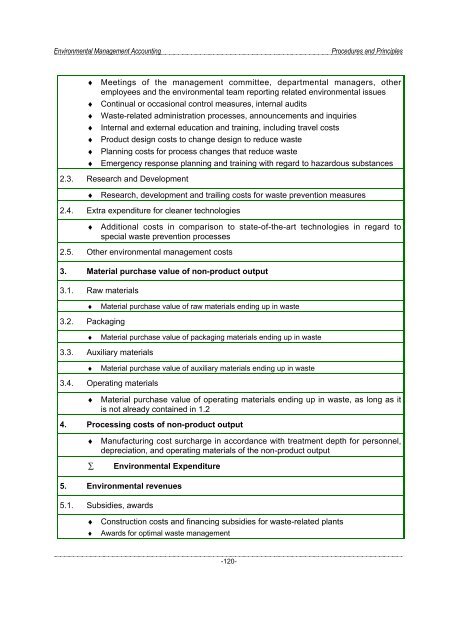Environmental Management Accounting Procedures and Principles
Environmental Management Accounting Procedures and Principles
Environmental Management Accounting Procedures and Principles
You also want an ePaper? Increase the reach of your titles
YUMPU automatically turns print PDFs into web optimized ePapers that Google loves.
<strong>Environmental</strong> <strong>Management</strong> <strong>Accounting</strong><br />
<strong>Procedures</strong> <strong>and</strong> <strong>Principles</strong><br />
♦ Meetings of the management committee, departmental managers, other<br />
employees <strong>and</strong> the environmental team reporting related environmental issues<br />
♦ Continual or occasional control measures, internal audits<br />
♦ Waste-related administration processes, announcements <strong>and</strong> inquiries<br />
♦ Internal <strong>and</strong> external education <strong>and</strong> training, including travel costs<br />
♦ Product design costs to change design to reduce waste<br />
♦ Planning costs for process changes that reduce waste<br />
♦ Emergency response planning <strong>and</strong> training with regard to hazardous substances<br />
2.3. Research <strong>and</strong> Development<br />
♦ Research, development <strong>and</strong> trailing costs for waste prevention measures<br />
2.4. Extra expenditure for cleaner technologies<br />
♦ Additional costs in comparison to state-of-the-art technologies in regard to<br />
special waste prevention processes<br />
2.5. Other environmental management costs<br />
3. Material purchase value of non-product output<br />
3.1. Raw materials<br />
♦<br />
Material purchase value of raw materials ending up in waste<br />
3.2. Packaging<br />
♦<br />
Material purchase value of packaging materials ending up in waste<br />
3.3. Auxiliary materials<br />
♦<br />
Material purchase value of auxiliary materials ending up in waste<br />
3.4. Operating materials<br />
♦ Material purchase value of operating materials ending up in waste, as long as it<br />
is not already contained in 1.2<br />
4. Processing costs of non-product output<br />
♦ Manufacturing cost surcharge in accordance with treatment depth for personnel,<br />
depreciation, <strong>and</strong> operating materials of the non-product output<br />
∑<br />
<strong>Environmental</strong> Expenditure<br />
5. <strong>Environmental</strong> revenues<br />
5.1. Subsidies, awards<br />
♦ Construction costs <strong>and</strong> financing subsidies for waste-related plants<br />
♦ Awards for optimal waste management<br />
-120-




